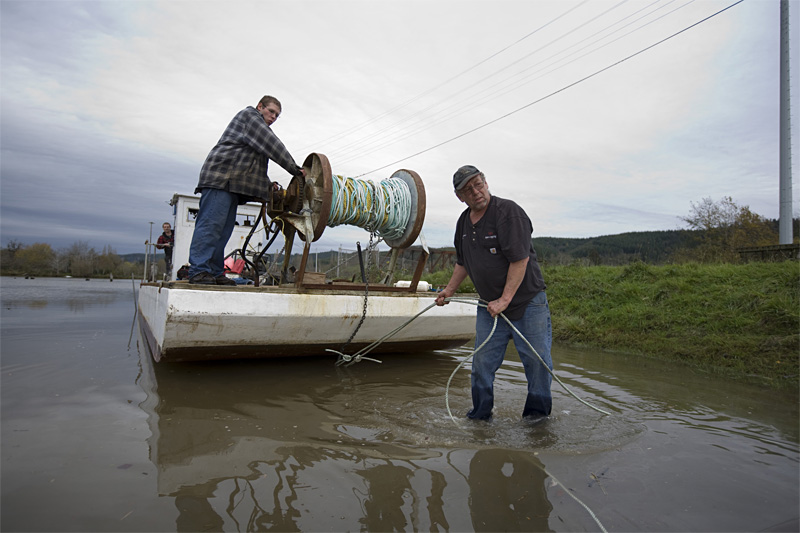Jimmy Smith points to an angry scar running the length of his stomach. “I got some stuff dropped on me,” is all he offers as explanation. Smith, a cast member on the History Channel reality show Ax Men, is giving a tour of his mangled body in an online video called “Jimmy’s Scars.” He goes on: “It tore my diaphragm loose…They had to cut me open.”
Then he points at his ankle, where he has another scar, jagged and outlined in red. He recalls how, after a fall, he had reached down to grab what felt like a stick in his boot. Instead, he realized, “I grabbed my bone.” The adventures of Smith and his South Cle Elum company, S&S Aqua Logging, are documented on Ax Men‘s third season, which premiered last week. Two Washington logging crews are featured on the show. Smith’s company scavenges local rivers for valuable timber that fell off log barges decades ago. There’s also Rygaard Logging, a father/son operation that cuts down trees on the Olympic Peninsula.
Whether pulling trees from above ground or underwater, the work is dangerous. The men are operating extremely heavy equipment (with giant tree cuttings dangling by ropes overhead) on rocky terrain. In the closing moments of the third season’s premiere episode, a log pierces the protective cage in which a machine operator had been sitting. That’s followed by the sound of a beeping hospital monitor.
So it’s no wonder that the cost of treating workers injured on the job is a pretty pressing concern for people in the logging business.
Gabe Rygaard, the son, says his premiums to the state’s workers’ compensation fund are by far his biggest expense. And getting bigger: Rates for loggers jumped 19 percent this month. Rygaard says he’ll be forced to cut other benefits to his employees, like regular health insurance. If rates get much higher, he says, he won’t be able to stay in business in this state at all.
Employers like Rygaard complain that Washington’s workers’-comp system is generous to the point of crippling employers. They believe rates are being raised to support ever-expanding benefits that are too easily obtained, and a bloated bureaucracy at the Washington State Department of Labor & Industries, the agency that oversees workers’ comp. And not only small-time operators are upset. Boeing cited the state’s workers’-comp system as one of the reasons it chose South Carolina for a second assembly line for its new Dreamliner. The Association of Washington Business argues that L&I too readily awards lifetime benefits to workers whose claims are specious at best and downright fraudulent at worst.
The state’s most outspoken and aggressive business lobby, the Building Industry Association of Washington, which represents home builders, has been grousing about L&I for years. The BIAW is quick to point out that employees who miss work due to injury stay on the state’s dime far longer than their counterparts in other states. And while businesses around Washington are laying off employees and making cuts, the 2,700-employee L&I is seeing its administrative costs rise.
Given the bad economic climate and the shocking loss of Boeing’s assembly plant, these longtime complaints are getting a new hearing, as even liberal politicians worry about the state’s “business climate.” Two bills have already been introduced in the current legislative session to try to reform the workers’-comp system.
But politically powerful labor unions aren’t likely to let much happen. They treasure Washington’s system, which offers the third-most-generous benefits package among all states, according to the National Academy for Social Insurance, a D.C.–based think tank that evaluates government programs like Social Security and workers’ comp.
In Washington, an injured employee can start collecting a paycheck from the state after just three missed workdays, rather than the seven required in most states. While most states only replace two-thirds of your salary while you’re off work, Washington pays as much as 75 percent. And for people who are declared unable to work for life, the annual amount they receive to cover lost wages is adjusted for inflation, something most states don’t do.
The great thing about Washington, says Tacoma attorney Terri Herring-Puz, who represents employees in workers’-comp disputes, is that the system is run entirely by the government, with no private companies participating. We’re one of only four states in the country where that’s the case. As she sees it, the state has no incentive to avoid paying claims in order to satisfy shareholders. “We have a nonprofit system,” Herring-Puz says. “It’s not an insurance carrier who needs to make money above what they pay out in benefits.”
But to the BIAW, the lack of competition “has led to an inefficient, bloated bureaucracy that squanders employers’ tax dollars and gives injured workers the run-around,” as the organization said on its blog “The Hammer” last fall.
Attorney General Rob McKenna, Secretary of State Sam Reed, and the Republican party leaders in the state legislature recently authored an op-ed in The Seattle Times calling for, among other things, allowing private competition in the state’s “job-killing workers’-compensation system.” House Republicans introduced such a bill last week.
That’s likely more than they’ll be able to pull off this session, or anytime soon. But the Association of Washington Business is backing a bill, with support from both parties, that would tighten constraints on who qualifies for workers’ comp and give businesses the option to settle out of expensive ongoing claims with lump-sum payments.
Herring-Puz says these bills are “blatant attempts to cut benefits, and that’s all they are.” Jeff Johnson, a lobbyist for the Washington State Labor Council, says businesses’ objections to the system are “preposterous.”
The four Democrats who co-sponsored AWB’s bill stand to incur Labor’s wrath. All four have received donations from unions in the past, but the Labor Council says it will withhold support from anyone who backs business on this issue.
Logging has been in Gabe Rygaard’s family since his grandfather arrived in Port Angeles in the 1950s. He and his father first tasted televised fame when they got a call in the spring of 2008 from a producer wanting to send out a camera crew for an episode of NBC’s America’s Toughest Jobs.
“Out of that, I guess they liked us, and we were kind of discovered,” he says. Rygaard suspects that the draw was his relationship with his father. Mostly the pair do a lot of yelling. The senior Rygaard is skeptical of anything new; his son is a risk-taking entrepreneur.
After America’s Toughest Jobs aired, Rygaard got a call in August 2008 from a production company working with the History Channel on the Ax Men series. The Rygaards were added for the show’s second season.
Rygaard says the danger and drama of his industry is played up in the editing. But what he does is still very risky work, he admits. “I’ve had guys break arms and legs on the job, and we’ve had to pack them out.”
Rygaard says that at this point, he’s paying up to $18 an hour per employee for workers’-comp coverage, depending on their responsibilities. “That’s a wage, that’s a family earning job wage that I’m paying L&I,” he says. Rygaard says that thanks to the recession and a stalled-out home-building market, it’s hard enough to stay afloat. Even with the money he gets for being on the show, his business hasn’t seen a profit since 2006, he says.
The impact isn’t only on clearly dangerous industries like logging. Judy Coovert, who owns a Seattle office-supply and printing company called Printcom, says that thanks to a down economy, she’s dropped from 13 full-time employees in 2008 to eight full-time and one part-time today. Despite her smaller staff, she says, the rate hike will make it hard to keep the workers she still has, let alone hire any back. Coovert managed to avoid filing a single workers’-comp claim last year, but her industry’s rates still went up 11 percent, thanks to claims at similar businesses.
While having no claims qualifies her for a discount on workers’-comp payments, her unemployment-insurance premiums more than tripled thanks to the layoffs. “It just piles it on,” Coovert says. “The cost of doing business has increased horrendously in 2010.”
“We feel like businesses are suffering a death by a thousand cuts,” says George Allen, Senior Vice President of Government Relations at the Greater Seattle Chamber of Commerce. “And unemployment and workers’ comp aren’t just surface wounds, they cut pretty deep.”
Allen adds that as far as his organization is concerned, the legislature doesn’t only need to make Washington a more attractive place for businesses to relocate. It needs to worry about job retention by avoiding large rate hikes. “We don’t want to put a squeeze on businesses who are trying to keep the employees they already have,” he says.
L&I spokesperson Elaine Fischer says the rate hike is necessary due to a combination of three factors: Rising unemployment has resulted in lower payments into the fund the department uses to pay out claims; the weak stock market has produced poor investment returns on money held by the department; and health-care costs, of course, continue to increase.
The state also is seeing a rising number of “compensable claims.” With these, the state pays not only your medical bills, but 60 to 75 percent of your salary while you are unable to work. If you are deemed unable to return to work at all, you’ll get that percentage for the rest of your life (unless you go back to work or start collecting money from somewhere else, like Social Security). Those claims make up only 18 percent of L&I’s load, Fischer says. In the majority of cases, the department only pays for medical bills. But that small percentage constitutes the vast majority of L&I’s costs. And since long-term claims are adjusted for inflation, they get costlier every year.
Currently, the average length of time that people collect pay from the department is 270 days, according to L&I’s latest quarterly report. That’s more than double the national average, or so says a survey of 37 states by the National Council on Compensation Insurance, a Boca Raton, Fla., company that tracks workers’-comp data for states where private insurers sell the coverage, not just the government.
L&I argues that this higher days-off average is skewed by a few claims that drag on for decades. The agency says the median number of days-off paid on compensable claims is only 40, compared to a national median of 45 days. One thing’s clear, though: The people who collect workers’ comp long-term in Washington are staying on it far longer than people in other states do.
Donna Pieze, who owns a heating and air conditioning business in Port Orchard, says that while she doesn’t see the dramatic accident claims that a logging company does, her longtime employees do file far more expensive long-term disability claims, as their hands and wrists begin to give out as they age.
At an Oct. 29 hearing in Bellingham on L&I’s rate hike, Pieze testified that the current system punishes employers who retain employees past their physical prime, since inevitably they begin to have problems. “For an industry that’s very physical, it’s just going to happen,” she said.
Boeing spokesperson Bernard Choi cites similar issues for his company. Over the past decade, according to Choi, the annual number of injury claims at Boeing has dropped from 8,600 to 3,800. “So we should be paying less, right? It’s the opposite.” That’s because of ongoing, long-term claims, including people who have qualified for lifetime payouts, or “pensions.”
Boeing does not have to worry about insurance rates: Like other big companies, it’s allowed to be “self-insured,” meaning the company doesn’t pay premiums to the state, it just pays out-of-pocket when workers are injured on the job. But the state still decides who qualifies for a pension.
Costco sees the same problem, according to Katrina Zitnik, who oversees workers’ comp for the giant Issaquah-based retailer. Zitnik says an exceptionally high percentage of Costco employees receive pensions in Washington compared to the 39 other states where the company does business. Last year, a total of 1,771 people (from all employers) were awarded pensions in Washington. Oregon approved only 14. Zitnik says cost-of-living raises more than double the annual amount the company pays out for pensions each year.
For smaller companies that are insured by the state, L&I has the burden of paying out the pensions. But whenever a business has pensions awarded against it, it can see premium rates go up dramatically.
The pensions also make running L&I more expensive. Administrative costs at the agency have jumped 82 percent over the past decade. L&I’s Fischer says that number tracks a 73-percent increase in the total benefits paid out during that time. The biggest contributing factor to that increase is the pensions.
The high number of pensions is almost inevitable under state rules. If you had a back injury, got a job at a Costco, and worsened that pre-existing injury, Costco would still be considered responsible for covering the entire pension.
“In this state there’s almost no test for the injury, [to determine] if that was work-related,” Zitnik says. “The occupational-disease situation is very, very liberal compared to all the other states that we work in.”
Oregon passed a law in 1990 requiring claimants to show that their job is the “major contributing cause” of their injury. In Washington, an employee only has to show that their job was a “proximate cause.”
“It’s to the point that anything goes if it can be somehow plausibly claimed to be work-related,” says Kris Tefft, Director of Government Affairs for the Association of Washington Business. “As people get older, look at the end of their career, trying to find a pension or supplement, filing an occupational-disease claim becomes a very attractive option.”
Thanks in part to rising costs from paying out pensions, a study commissioned by State Auditor Brian Sonntag recently determined that Washington’s workers’-comp fund will be broke in two years—even with the current rate hike. Resolving that shortfall would require an even steeper hike—about 33 percent, according to the audit.
L&I Director Judy Schurke, who declined to be interviewed, sent a letter to Sonntag’s office saying her department decided to go with a lower average rate increase to avoid a sudden and dramatic jump in the cost of doing business in the state. The department will be paying out benefits in part from a reserve fund, which, Schurke notes, was created to handle a down economy. For instance, she writes, during the 1980s, L&I owed more money than it took in, but was able to cover the difference out of reserves until the economy turned around, at which point insurance premiums rebuilt the fund.
The two most common types of injuries for which people make workers’-comp claims are strain to the neck and back. The industries with the highest incidence of those injuries involve heavy lifting—loggers and builders, for example, along with nursing-home attendants, garbage collectors, and grocery-store employees.
Rygaard acknowledges that his business is extremely dangerous. His problem, he says, is that while every claim makes his rates go up, his workers regularly apply for L&I benefits for injuries that barely, if at all, meet the “proximate cause” standard. Almost everyone knows stories of rampant fraud and abuse that they claim goes largely unchecked.
When L&I announced last fall that it would hike rates across all industries by an average of 7.6 percent, business owners arrived at hearings around the state with tales of former employees who collected thousands of dollars while continuing to work other jobs or just vacationing.
Barry Swanson, who owns a logging and trucking company in Forks, told of seeing former employees on disability around town, working under the table or out hunting. When he challenged one worker’s disability claim, he recalls, the guy showed up to the hearing at the wheel of a dump truck he’d started driving for extra income. “Fraud is rampant,” he declared. “I might as well tell my guys to sign up for your retirement plan.”
There is no argument that fraud is occurring. Of L&I’s 2,700 employees, 234 are devoted to fraud and compliance. And since the beginning of 2009, the state has recouped more than $161 million from people who fraudulently received benefits (and in a few cases, businesses that dodged their premiums by paying employees under the table). State investigators found workers’-comp claimants doing everything from running businesses to, in one man’s case, climbing Mount Rainier—after having been declared permanently disabled four years earlier. (He justified it to an Associated Press reporter by arguing that climbing mountains takes leg strength, not a good back. He has pleaded not guilty to charges of first-degree theft in Pierce County Superior Court.)
Jimmy Smith himself, of Ax Men, may become one of those cases. According to L&I fraud spokesperson Barbara Davis, Smith is currently being investigated for the possibility of fraudulently receiving disability payments. Smith confirms by phone that he was awarded a lifetime pension from L&I on account of his severe injuries. He says that S&S Aqua Logging belongs to his son, and that he doesn’t actually work, he just advises. All money for appearing on Ax Men went to the company, he says. “I never made a dime [off the show],” he says, adding “I’ve been so busted up, it’s not like a fake injury.”
Union activists insist that, compared to other states, employers actually have it better in Washington. They point to a study, released every two years by a state agency in Oregon, which compares the cost to businesses of insuring their employees. The most recent study, published last March, found that per $100 of payroll, Washington employers have the fifth-lowest costs in the U.S. Even Oregon, the state that our business leaders say we should be emulating, is slightly more expensive, according to the study.
Jeff Johnson, a lobbyist for the state Labor Council, cites the Oregon study to say that businesses’ complaints are without merit. “The Oregon study is the only study, and the most reputable in the country, that does cross-state comparisons.”
But business representatives are highly skeptical of the study’s accuracy. “The notion that we can offer the highest benefits in the country at the lowest premium doesn’t make any sense,” argues AWB’s Tefft.
Blurring the picture is the fact that Washington sets its rates based on hours worked, not on payroll, which is what the study measures. Employers in Washington can also have their employees contribute up to 28 percent of the amount collected by the state to fund workers’ compensation, though that’s only voluntary.
“It’s real hard when you take systems as dissimilar as Oregon and Washington,” acknowledges Mike Manley, who manages the Oregon study. “There’s a lot of approximations and assumptions that have to go on.”
The Oregon study is likely to come up a lot in Olympia, as debate gets underway about reform. AWB hopes to pass legislation allowing for one-time, lump-sum settlements rather than ongoing pensions. Choi says that’s a big issue for Boeing. Businesses would then have a known, rather than an unknown, cost. And there’d be less potential for fraud, since the worker would be free to find a way to start making money again. AWB also wants to require claimants to show more specifically how their injury is tied to their work, similar to the rule in Oregon.
Finally, the AWB legislation would create a medical-provider network. Instead of being allowed to see your own doctor when filling a workers’-comp claim, you would have to see a pre-approved doctor who would use a standard set of guidelines for setting treatments and determining if and when you could go back to work. Zitnik says that when California created a similar network, Costco’s workers’-comp payments dropped dramatically.
AWB’s bill is awaiting a hearing in Olympia.
Joe Schwab, an attorney from Moses Lake who represents injured employees, says the biggest problem with settlements is what happens when a condition worsens over time. If someone were to accept a cash payout to close their claim, it would be more difficult to get treatment later if a back injury didn’t resolve as expected or became more painful. Businesses will work to “get someone to sign on the dotted line and give up their rights,” Schwab says. “Do we let the less-educated person be victimized by the better-educated person with the checkbook?”
Herring-Puz contends that the people who are pushed off workers’ comp through measures like those advocated by AWB will end up on welfare or Social Security instead—meaning the money will still come out of taxpayers’ pockets. “If we don’t call it an occupational disease, it doesn’t mean they’re not hurt. It just means the employer doesn’t pay for it,” Herring-Puz says.
This year’s legislative session ends on April 7, so all bills are fighting for attention, especially in light of the looming $2.6 billion budget deficit. But businesses are seeing a rising tide of support for serious reform. The Spokesman-Review in Spokane and the Tacoma News Tribune editorialized in favor of dramatically overhauling the system, and the traditionally Republican call for shrinking government appears to be gaining ground among Democrats too. Rygaard’s wish to take an ax to L&I may yet come true.








